The post The Bedis in Punjabi Society first appeared on Sindh Courier.
]]>RATTAN SINGH
The Bedis are a small clan among the Khatris, gaining distinction due to the birth of Guru Nanak into it. Many Bedis trace their descent from Baba Lakhmi Chand, the son of Guru Nanak. The Bedis historically congregated at Dera Baba Nanak but eventually created more centers at Una and Kallar. Their role in Punjabi society was varied, including acting as a theocratic elite and at other times, performing roles suited to the development of their village.
Theocratic elite
As mentioned before, Bedis were considered the descendants of Guru Nanak. As a result, they were treated as a theocratic elite and would receive patronage under various kingdoms due to their wide influence.
Baba Kaladhari
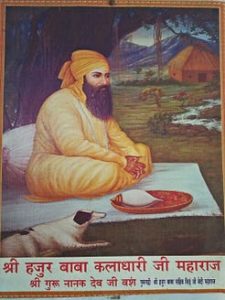
Dera Baba Nanak was founded by Guru Nanak, on the banks of the Ravi, alongside Kartarpur. The Bedis traditionally resided here until Baba Kaladhari, the ninth descendant of Guru Nanak, created further establishments including Una and the village of Bedian near Lahore. The Una establishment was founded by Baba Kaladhari, during the time of the 10th Guru. Nearby, Baba Kaladhari met Guru Gobind Singh at Bathu, where the Gurudwara Sri Gurplaha Sahib stands today. Since Una became a burgeoning pilgrimage centre, the Raja of Jaswan granted Baba Kaladhari several jagirs.
Baba Sahib Singh Bedi
After the death of his father Baba Ajit Singh, Baba Sahib Singh Bedi became the primary jagirdar of Una, gaining immense popularity throughout Doaba. Maharaja Ranjit Singh offered him further jagirs of villages in Gujranwala and Lahore. He is perhaps best known for his coronation of Maharaja Ranjit Singh as the emperor of the Sarkar-i-Khalsa. Satbir Singh Bedi’s pamphlet on Baba Sahib Singh Bedi further describes the event:
1801 ਦੀ ਵੈਸਾਖੀ ਨੂੰ ਸ਼ਾਹੀ ਕਿਲੇ ਵਿਚ ਬਾਬਾ ਜੀ ਨੇ ਆਪ ਅਰਦਾਸ ਕਰਕੇ ਸਿੰਘ ਸਾਹਿਬ, ਮਹਾਰਾਜਾ ਰਣਜੀਤ ਸਿੰਘ ਆਖ ਕੇ ਵਰ ਦਿਤਾ ਤੇ ਮਥੇ ਉਤੇ ਕੇਸਰ ਦਾ ਤਿਲਕ ਲਗਾਇਆ। ‘ਸਤਿ ਸ੍ਰੀ ਅਕਾਲ’ ਦੇ ਜੈਕਾਰੇ ਛਡੇ ਗਏ। ਬਾਬਾ ਸਾਹਿਬ ਸਿੰਘ ਜੀ ਦਾ ਕਿਤਨਾ ਕੁ ਪ੍ਰਭਾਵ ਮਹਾਰਾਜਾ ਰਣਜੀਤ ਸਿੰਘ ਉਤੇ ਸੀ ਇਸ ਦਾ ਮੁਖ ਉਦਾਹਰਣ ਨਾਨਕ ਸ਼ਾਹੀ ਸਿੱਕਾ ਹੈ ।
On the Vaisakhi of 1801, Baba Sahib Singh Bedi performed ardas in the royal fort of Lahore, gave him the title of Maharaja and anointed him with a saffron tilak. Rallying cries of ‘Sat Sri Akal’ were heard. Baba Sahib Singh Bedi’s influence on Maharaja is visible from the Nanakshahi coin.
It was only under Maharaja Ranjit Singh that upkeep became prominent as jagirs were granted to influential Bedis such as Baba Sahib Singh Bedi, the grandson of Baba Kaladhari. Under Maharaja Ranjit Singh, Gurudwara Dera Baba Nanak was reconstructed with a marble floor and a guiled throne.
Baba Khem Singh Bedi
Baba Khem Singh was born from the Kallar branch of Bedis. He was given jagirs under the Sikh and British administration both. Under the British, his support was frequently called for due to his influence in Rawalpindi. He contributed to the opening of 50 schools with a specific insistence of progressing female education. Afterwards, he co-founded the Singh Sabha movement, particularly funding a Sanatan strand of Sikhi; a strand that was more liberal on living Gurus and other folk traditions. Many of Khem Singh Bedi’s followers would accept him as a living Guru. Bhagat Lakshman Singh’s autobiography describes Khem Singh Bedi’s appearance when riding to villages:
His figure was small and complexion rather dark. His eyes too were not very particularly bright. But he made up for all this by the costume he wore. He seems to have studied how to look grand and majestic. He rode out daily for Shikar with a hawk perching on his left hand. This position he carefully maintained even when presiding at the daily congregations. And if his idea was to actually look like the illustrious Guru Gobind Singh, it may be safely stated that he succeeded in this endeavor to no small extent. His followers believed him to be an avatar whose mere touch would save them.
Despite his transgressions, he would fulfil his role as a parcharak in the hinterlands of the subcontinent and Punjab. With the growing influence of Bedis, many would become headmasters or teachers, helping to grow education across Punjab and the Khyber.
Folk medicine practitioners
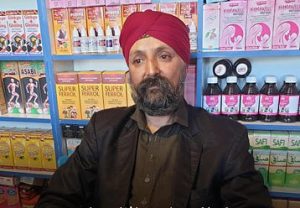
It is already well known that specific castes and tribes played specific roles in Punjabi society historically. Mirasis, Sainis and Bhats were all known for their role as genealogists alongside other roles, dependent on region. Bangalis would act as both snake charmers and herbal practioners, using esoteric medicine like giddar singhi (jackal’s horn) and billi di jer (cat’s placenta).
Since the Bedis were part of a Sikh elite, they were considered a distinguished community in a village setting and weren’t subject to any discrimination unlike the aforementioned groups. One of the less mentioned roles of Bedis was as folk medicine practitioners, able to cure fevers and malaria through various folk remedies. The novelist Dr. Sohinder Singh Wanjara Bedi in his autobiography ‘Adhi Mitti Adha Sona’ describes the potential origin of Bedis in curing intermittent fever in villages:
The first one details that once a patient of intermittent fever came to Guru Nanak when he was resting under a tree in the forest. He asked the patient to fetch gur (jaggery) from somewhere. When that man returned with jaggery, Guru Nanak removed the web of a spider, mixed it up with the jaggery and asked him to eat it. He was at once relieved of the fever. Since then the descendants of Guru Nanak are endowed with that blessing.
An alternate story attributes a Muslim fakir who cured a Bedi through rat excrement and jaggery instead. That fakir visited the Bedi village and was paid deep respects. Since the fakir was impressed, he granted the sarpanch of the Bedi village with the ability to cure malaria. This practice carried on until the early 1900s among the Bedis of Rawalpindi. As modern medicine became available, the role of Bedis as folk medicine practitioners declined. By the late 1940s, the Bedis of Rawalpindi had stopped performing folk medicine. Despite this, a few Bedis would still work as unani hakims (herbal medicine practitioners) in Afghanistan.
Conclusion
Due to the influence of Bedis through jagirs by Sarkar-i-Khalsa and then the British, they were able to act as a noblesse oblige to fund education and create institutions for the Sikh community, similar to the Sayyids among Indian Muslims. Due to the protestant influence among the Lahore Singh Sabha becoming more prominent, the Bedis’ influence slowly waned and other laymen were able to fulfil the role of parcharaks and religious intellectuals. By the end of the Akali movement, Bedis were only influential in select areas and some gurudwaras. With urbanization, Bedis lost their traditional customs including herbal medicine.
____________________
Courtesy: The Khalsa Chronicle (Received by email on Feb 4, 2023)
The post The Bedis in Punjabi Society first appeared on Sindh Courier.
]]>The post Sikhs of Dhamali first appeared on Sindh Courier.
]]>Zulfiqar Ali Kalhoro
There still live many oral historians and village intellectuals in the towns and villages of Pothohar who have preserved the history, heritage and lost traditions of their respective areas. During my research which spans two decades in the Pothohar region in Punjab, I met many such historians and village intellectuals to collect information on the oral history of villages and towns and their lost built heritage, traditions and customs of Pothohar. I met one such village intellectual in Dhamali village on the 14th of March 2021, who has not only preserved the oral history of his village but also the surrounding villages. His name is Jahandar Khan and he is 88 years old. He is a retired school teacher who possesses a wealth of knowledge which he has acquired through his lived experience in village and traveling in different regions of Pakistan.
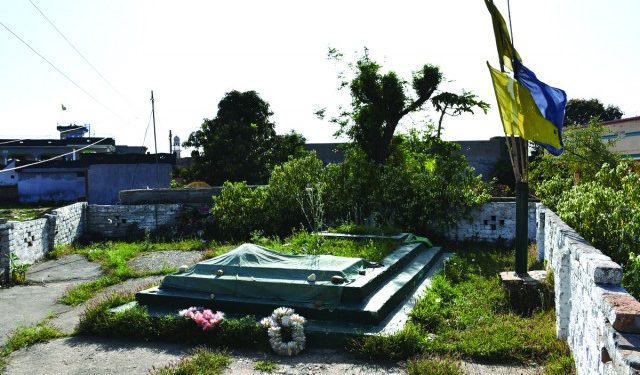
Dhamali is located about 5 km east of Kallar Syedan town on the Kallar Syedan-Doberan Road. There are two important sacred Muslim spaces in Dhamali village which include the shrine of Baba Karmat Hussain Shah Sabiri and a communal grave called Pakki Qabar. Legend has it that buried in Pakki Qabar are the first Muslim proselytizers who came from Central Asia to preach Islam in the village in the twelfth century. Before the Partition of 1947, Dhamali also called Thamali, was mainly inhabited by the Sikh community. There were also few households of the Hindu community. According to Jahandar Khan, there were only three households which belonged to the Awan family. The notable Awans of these three families were Malik Karam Khan, Malik Fazal Illahi, Malik Khan Muhammad and Malik Waris Khan.
The Sikhs of Dhamali were merchants and agriculturalists. They owned the markets and agricultural land in the village. There were three bazaars in Dhamali. All the shops in bazaars were owned by Sikhs and some by Hindus. Sikhs controlled the business of Dhamali and Doberan villages. They were also influential in other villages and towns namely Manglora, Kallar, Kanoha, Thoha Khalsa, Dera Khalsa in Kahuta tehsil (now Kallar Syedan) district. There were about 40 magnificent havelis of Sikhs and Hindus in Dhamali, all of which have now disappeared save one which was built by Parmeshri Kaur. Only the front of the choubara (mansion) of Parmeshri Kaur is extant now. It was a two-storeyed structure. The remains and ruins of the rooms and halls of the haveli of Parmeshri Kaur are extant in the heart of Dhamali village. It was a stone-built structure decorated with floral and geometric designs. The stone carvings on the pillars and spandrels of the haveli were remarkable, the traces of which can still be seen in the structure. In the same street were the havelis of some other notable Sikhs of the village. The havelis of Gopal Singh and his brother Dayal Singh were also famous buildings in the village. In fact, the havelis of both brothers were two-storeyed structures and noted for their wooden balconies and doors. The sons of Gopal Singh had a transport business. Dayal Singh had four sons: Jawant Singh, Kartar Singh, Rajandar Singh and Mehtab Singh. Jawant Singh, who was the elder son of Dayal Singh, had a cloth shop in the Dhamali bazaar. Kartar Singh son of Dayal Singh had a grocery shop in the Dhamali bazaar.
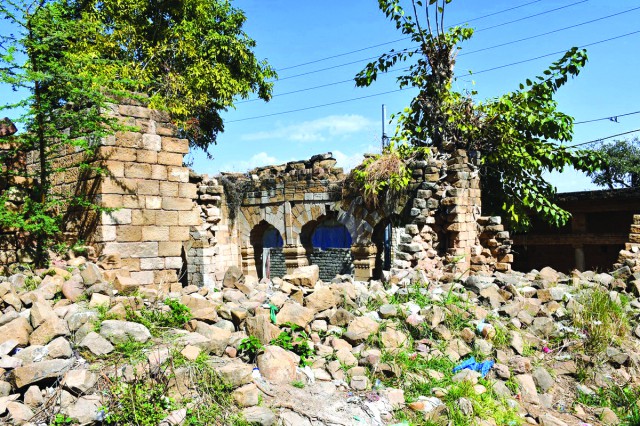
Mohan Singh, Charan Singh, Gian Singh, Gokal Singh, Kharak Singh, Labh Singh, Mahinder, Hardit Singh, Ram Singh, Santokh Singh, Ganda Singh, Hira Singh, Suraj Singh, Harbans Singh and Sardar Singh were all known notables of Dhamali. The havelis of these village elites dominated the landscape of Dhamali village. Ram Singh ran the business of brick kilns in Dhamali and neighbouring villages. The havelis of Suraj Singh and Hira Singh were also noted for their woodwork and embellishments. And the haveli of Sardar Singh was also a famous building in Dhamali. He had a jewellery shop in the bazaar. He was also assisted by his son Kuldip Singh. The wife of Sardar Singh, Rakhi Kaur, was an influential lady in Dhamali village. All the havelis have become history now.
There existed a well which was believed to have been dug by Hari Singh Nalwa, a famous general of Maharaja Ranjit Singh
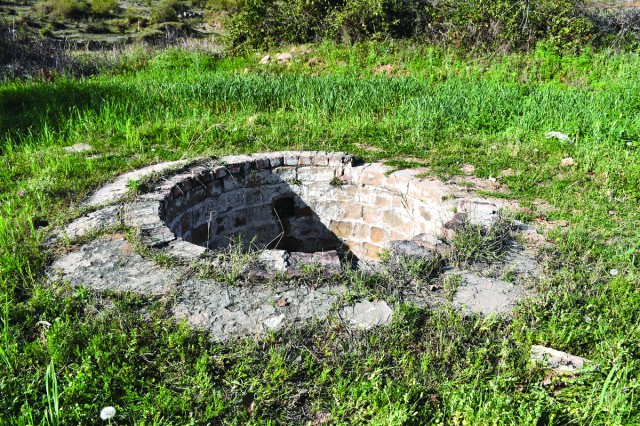
Wells and tanks built by Sikhs still mark the landscape of Dhamali village. Maha or Mai Rami who was known for her welfare works in the village got a well dug for the villagers. But the water well was brackish and it was soon abandoned. Another well in the village was dug by Balwant Singh which was located near a school in the village and was named after him. There also existed a well which was believed to have been dug by Hari Singh Nalwa (d.1837), a famous general of Maharaja Ranjit Singh. Hari Singh Nalwa’s in-laws were from Dhamail village. The famous well in Dhamali was Chariyan wala Kunwan. This well was used by the villagers and was located near the Shamshan Ghat (Hindu crematory ground). Two of the old village tanks are still extant in the village which were built by Sikhs of Dhamali. There was also a single-story house of Sain Lok. Now this Sain Lok had a large snake and he used to entertain the villagers and earn his livelihood by this profession.
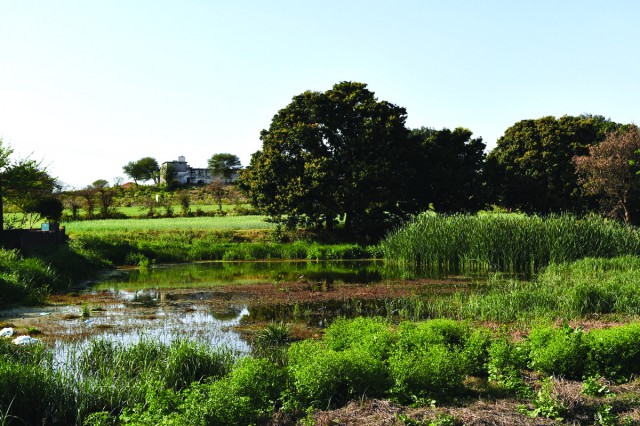
Jahandar Khan studied in the primary school of Dhamali and remembers the names of his Hindu and Muslim teachers too. The names of school teachers in Dhamali were Parcha Singh of Dhamali, Ujjar Singh who was a resident of Doberan, Sant Singh Suri, who was from Choa Khalsa, Sardar Khan of Manglora village, Karam Das of Mali Malikan and Master Muhammad Shafi of Mali Vens village.
According to Master Jahandar Khan, there were about ten households of Hindus in Dhamali. The names of notable Hindus of Dhamali included Dr. Dhanraj and three brothers Indar Chander, Balam Khand and Tara Chand. The havelis of Hindus do not exist now. The temple, which was located in Dhamali village, has also disappeared now.
There was also a gurdwara in Dhamali village which has disappeared now. It is believed that Sant Attar Singh Ji of Mastuana (1866-1927) undertook Akhand Paath (a three-day uninterrupted rendition of sacred hymns from the Guru Granth Sahib) in the Gurdwara of Dhamali. He was invited by his friend Bhai Sant Ram Singh. The Sikhs of Dhamali were followers of Sant Attar Ji. The Sikhs were also followers of Baba Khem Singh Bedi as he was a spiritual leader of Sikhs of Kallar, Kahuta and other areas in Rawalpindi district. After his death in 1905, many Sikhs of Dhamali became the disciples of Sant Attar Singh Ji. The gurdwara of Dhamali was built by Sant Bhai Ram Singh who was also known for his piety in the village and area. The gurdwara was located on a picturesque setting at the bank of stream locally called Kasi. The brother of Sant Bhai Ram Singh, Sant Bhai Jawahar Singh was also a pious person. He served every passerby, sadhus and sants, with food. And he also provided shelter to them. It was believed that nobody went hungry from this gurdwara. Today, this place is called Sanata dera. There was also a well there which was called Kasi wala Kunwan or Sanatan wala Kunwan.
After his death in 1927, his ardent disciple Sant Teja Singh Ji (1877-1965) continued to spread the thought and ideology of his mentor. Sant Teja Singh Ji toured the entire Pothohar region, collecting donations for the construction of the Gurdwara Tapiana Sahib at Kanhoa. The Sikhs of Dhamali generously contributed to the construction of Gurdwara Tapiana sahib at a place where Sant Attar Singh Ji had mediated. The Sikhs of Dhamali also attended the inauguration ceremony of Taposthan Kanoha alias Gurdwara Tapiana Sahib. Like many others in Dhamali village, Jamadar Gurdit Singh of Dhamali was a devout disciple of Sant Teja Singh Ji.
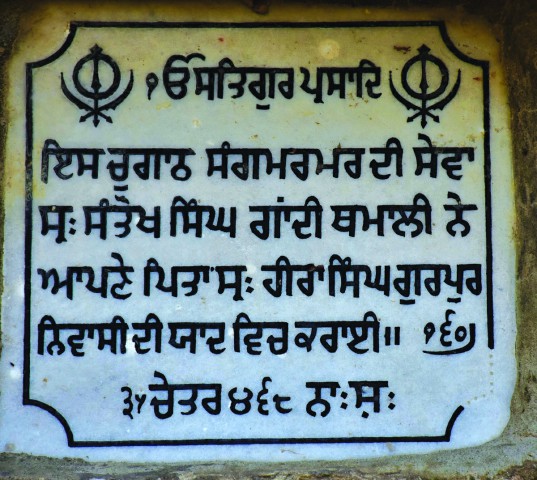
The Gurdwara Tapiana Sahib is a three-storyd building. There are about 18 donor plaques in Gurmukhi on the walls of the gurdwara which I have documented. At least 5 donor plaques record the names of residents of Dhamali who contributed to the construction of the gurdwara. From these donor plaques, one also comes to know the family names – Suri, Sarka, Gurpur, Gandhi, Bindra – of some of the notable Sikhs of Dhamali. The name of one of the donors appears on the chaukaath (wooden door frame) of the gurdwara as Santokh, who donated wooden frame and marble in memory of his father Hira Singh. The second donor plaque reads Mai Gur Daee wife of Sardar Atma Singh Ji Munshi who donated Rs. 201 in memory of her son Sardar Nirvair Singh Ji Gurpur resident of Thamali/Dhamali. The third donor plaque bears the name of Raja Singh Ji Sarla who donated Rs. 51 in memory of his respected father Sardar Teja Singh Ji Gadari Wale Haal Dhamali through Jamadar Gurdit Singh. The fourth donor plaque reads only that Lambardar Dhamali donated Rs.21. The fifth plaque records the name of Raj Devi wife of Sardar Uttar Singh Bindra of Thamali/Dhamali who donated Rs. 25 through Sardar Hukam Singh. Bhai Sardar Hukam Singh was the resident of Bishan Daur (now called Dewan Huzoor village) in Sohawa, Jhelum. He was a member of Gurdwara Tapiana Sahib Committee which also comprised Bhai Sanokh Singh and other prominent persons of the area. The main duty assigned to Bhai Bishan Singh was to look after the construction of Gurdwara Tapiana Sahib at Kanoha. Bishan Singh also was from Bishan Daur village in Sohawa, Jhelum. He got two small rooms constructed but could not undertake the construction of the Gurdwara Tapiana Sahib and disappointed, he went to his village Bishan Daur.
____________________
 Zulfiqar Ali Kalhoro is an anthropologist and author of 12 books including ‘Symbols in Stone: The Rock Art of Sindh’, ‘Perspectives on the art and architecture of Sindh’, ‘Memorial Stones: Tharparkar’ and ‘Archaeology, Religion and Art in Sindh’. He may be contacted at: zulfi04@hotmail.com
Zulfiqar Ali Kalhoro is an anthropologist and author of 12 books including ‘Symbols in Stone: The Rock Art of Sindh’, ‘Perspectives on the art and architecture of Sindh’, ‘Memorial Stones: Tharparkar’ and ‘Archaeology, Religion and Art in Sindh’. He may be contacted at: zulfi04@hotmail.com
Courtesy: The Friday Times Lahore
The post Sikhs of Dhamali first appeared on Sindh Courier.
]]>The post Nanakpanthis in Mithi first appeared on Sindh Courier.
]]>By Dr. Zulfiqar Ali Kalhoro
Mithi, the headquarters of the Tharparkar district in Sindh, has also a small number of Nanakpanthis, mainly the Mangnani lineage of Lohanas. Generally, it is believed that the majority of Hindus in Sindh are Nanakpanthis – which is not true. On the contrary, the majority are Matapanthis (worshippers of Devi Mata – Durga and many of her incarnations). In fact, it is mainly the upper caste Hindus who are Nanakpanthis in Sindh. The lower caste Hindus are not Nanakpanthis, although there are a few converts amongst them who claim themselves to be Sikhs and sometimes Nanakpanthis.
In Tharparkar district, the case is entirely different from all other districts in Sindh. A majority of Hindus adhere to cult of Devi Mata and follow major Hindu deities Shiva, Vishnu and two of his most popular incarnations – Rama and Krishna too. Hanuman is also worshipped by all Hindus in Tharparkar like in all other districts of Sindh. A majority in rural Tharparkar follow folk deities namely Rama Pir, Pir Pithoro, Pabuji Rathore, Gogo Chauhan, Khetarpal and Hindus ascetics including Sant, Sami, Puri, Gar, Bharati and Nath ascetics and Muslim saints. The cults of Jhujhar(deified heroes) and Sati (Widow-burning) also constitute pantheon of Hindus in Tharparkar.
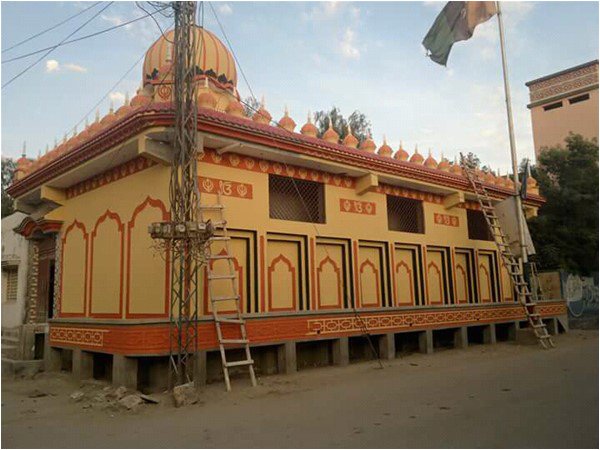 A majority of Hindus also venerate Muslim saints and have constructed impressive tombs over the mortal remains of saints in Tharparkar. When elite Hindu women cannot travel frequently to the shrines of Muslim saints in the villages, they instead venerate those Muslim saints at Astans which have been constructed by the rich Hindu community in their localities in the towns of Tharparkar.
A majority of Hindus also venerate Muslim saints and have constructed impressive tombs over the mortal remains of saints in Tharparkar. When elite Hindu women cannot travel frequently to the shrines of Muslim saints in the villages, they instead venerate those Muslim saints at Astans which have been constructed by the rich Hindu community in their localities in the towns of Tharparkar.
In the mornings and evenings, when Hindus go to the temples, they also visit and get the blessings of the saints at the Astans in Mithi. Located in Lohana Mohalla of Mithi is an impressive building which houses the symbolic grave of Sain Mard Faqir whose original shrine is located in Kerti village which lies 45 km southeast of Mithi town. Sain Mard Faqir is worshipped by the Ghindilya lineage of Lohana Hindus. Located in the same street is the Guru Nanak Darbar, formerly Gurdwara, which has recently been rebuilt by Lohana of Mithi and Thana Bula Khan with a major contribution coming from Ramesh Khumwani of Thana Bula Khan. This is the only Nanakpanthi shrine in the whole of Tharparkar district.
Apart from Tharpakar, there is also a Nanakpanthi shrine, locally called Tikano, in Umarkot, a gateway to Thar. Guru Nanak Darbar’s outer walls and the main entrance are decorated with Sikh symbols-Khanda and Ek Onkar, showing that the building is a Sikh shrine belonging to Nanakpanthis – Hindus who venerate Guru Nanak. In the interior walls of the darbar are written “Waheguru” in Sindhi language, refereeing to God, the Supreme Being or the creator of all. The word “Waheguru” is flanked by symbols of Ek Onkar and Khanda in the interior of the Guru Nanak Darbar.
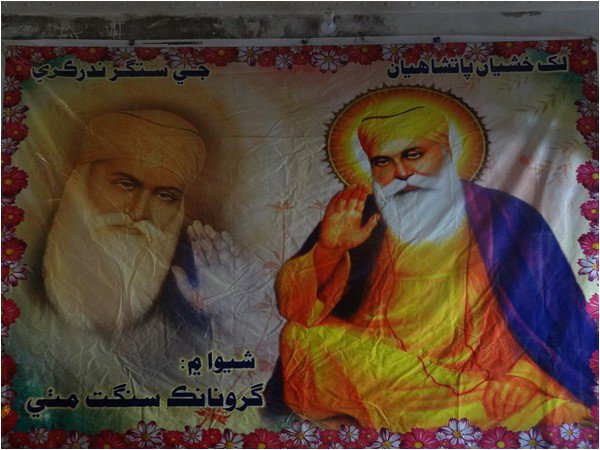 Guru Nanak Darbar was a small building before Partition, and was taken care of by a Sikh. Both the temple and Gurdwara (as it was called before Partition) were located in the same building. After the Partition, the Gurdwara was managed by Karo Mal and later by Bhagwan Das. In 2012, the Hindu community decided to rebuild the Guru Nanak Darbar. Today, the Guru Nanak Darbar is the only Nanakpanthi shrine in Mithi. The Mangnani lineage of Lohanas are the only Nanakpanthis in Mithi. There are two halls in the darbar, in one of which is placed the Guru Granth Sahib. The other serves as a Kirtan Halland Pathshala where the young Hindus are taught the Gurmukhi script – thus enabling them to understand the Guru Granth Sahib. Two young Hindus from Thana Bula Khan town in Jamshoro district came to Mithi about 5 years ago to teach Gurmukhi to forty young Hindus. Now these young Hindu are teaching Gurmukhi to their children.
Guru Nanak Darbar was a small building before Partition, and was taken care of by a Sikh. Both the temple and Gurdwara (as it was called before Partition) were located in the same building. After the Partition, the Gurdwara was managed by Karo Mal and later by Bhagwan Das. In 2012, the Hindu community decided to rebuild the Guru Nanak Darbar. Today, the Guru Nanak Darbar is the only Nanakpanthi shrine in Mithi. The Mangnani lineage of Lohanas are the only Nanakpanthis in Mithi. There are two halls in the darbar, in one of which is placed the Guru Granth Sahib. The other serves as a Kirtan Halland Pathshala where the young Hindus are taught the Gurmukhi script – thus enabling them to understand the Guru Granth Sahib. Two young Hindus from Thana Bula Khan town in Jamshoro district came to Mithi about 5 years ago to teach Gurmukhi to forty young Hindus. Now these young Hindu are teaching Gurmukhi to their children.
At Darbar, Nanakpanthis chant Shabad Kirtan, singing hymns from the Guru Granth Sahib. It is believed that Shabad Kirtan began in the sixteenth century as a musical expression of mystical poetry and accompanied by the musical instrument Rabab by Bhai Mardana, a Muslim follower of Baba Guru Nanak. Two of companions of Guru Nanak, Bhai Mardana and Bhai Bala, are always shown with Guru Nanak in the carved doors of Nanakpanthi Darbars in various towns in Sindh. Some of the most refined wood carvings of Guru Nanak with his companions are found in the doors of Shikarpur, Rohri, Mehar and Khairpur.
 Apart from Shabad Kirtan, Akhand Path another important Sikh practice, the nonstop recitation of all verses in the Guru Granth Sahib from beginning to end is also performed once a year at the Guru Nanak Darbar of Mithi. This is a common practice in all Nanakpanthi Darbars of Sindh, where Nanakpanthi Hindus perform continuous reading of the Guru Granth Sahib. Besides, Gurpurab celebrations are also done at the Darbar in Mithi.
Apart from Shabad Kirtan, Akhand Path another important Sikh practice, the nonstop recitation of all verses in the Guru Granth Sahib from beginning to end is also performed once a year at the Guru Nanak Darbar of Mithi. This is a common practice in all Nanakpanthi Darbars of Sindh, where Nanakpanthi Hindus perform continuous reading of the Guru Granth Sahib. Besides, Gurpurab celebrations are also done at the Darbar in Mithi.
Langar, a special community lunch, is arranged by caretaker of the Guru Nanak Darbar which lasts for two days. During the Langar, Hindus of lower and upper castes eat together at one place – a reflection of tolerant Sindhi society that transcends religious and caste barriers. Muslims also come to eat at the Darbar during the Langar, which is the best example of interfaith harmony to be seen at the Guru Nanak Darbar in Mithi. This interfaith harmony in Sindh has provided much space and solace to the Hindu community in Sindh, who are building impressive temples and grand Gurdwaras. This is one of the reasons that Nanakpanthis are building Darbars and Gurdwaras everywhere in Sindh. One of the largest Gurdwaras, in fact, is being built in Hyderabad on the Hyderabad Bypass near the Rajputana Hospital by the Nanakpanthis.
_______________________
Courtesy: Pakistan Institute of Development Economics (The article was originally published by The Friday Times, Lahore in 2018)
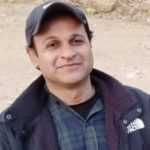 Zulfiqar Ali Kalhoro, PhD, is an anthropologist and assistant professor at the department of Development Studies at the Pakistan Institute of Development Economics (PIDE), Islamabad. Dr. Zulfiqar has been exploring and writing about the less-known and unknown heritage of the subcontinent since 1998, when he was a student of Anthropology at Quaid-i-Azam University, Islamabad.
Zulfiqar Ali Kalhoro, PhD, is an anthropologist and assistant professor at the department of Development Studies at the Pakistan Institute of Development Economics (PIDE), Islamabad. Dr. Zulfiqar has been exploring and writing about the less-known and unknown heritage of the subcontinent since 1998, when he was a student of Anthropology at Quaid-i-Azam University, Islamabad.
The post Nanakpanthis in Mithi first appeared on Sindh Courier.
]]>